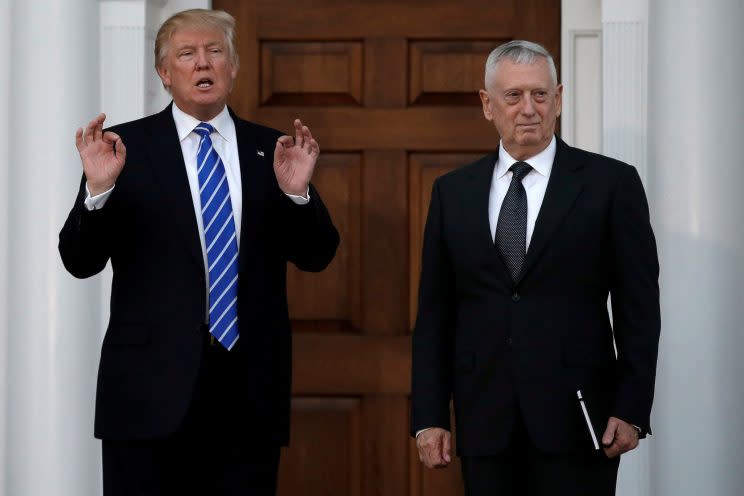In Gen. Jim Mattis, Trump chooses a ‘warrior monk’ as secretary of defense
Donald Trump was expecting a very different answer when he asked retired Marine Gen. James Mattis, at a meeting last month, for his views on the use of waterboarding. Misled, perhaps, by Mattis’s nickname, “Mad Dog,” and his reputation as a hard-charging commander of American forces in Afghanistan and Iraq, the president-elect expected Mattis to echo his own loudly expressed view, that in dealing with terrorists “You have to fight fire with fire.”
Instead, Trump recalled, “He said — I was surprised — he said, ‘I’ve never found it to be useful.’ He said, ‘I’ve always found, give me a pack of cigarettes and a couple of beers, and I do better with that than I do with torture.’”
That anecdote says at least two things about the man who, as Trump announced at a rally Thursday, is his choice to head the Defense Department, and if confirmed by the Senate, would be the highest- ranking military veteran in the post since the five-star Gen. George Marshall in 1951: He thinks for himself, and he is unafraid to speak his mind — even at the risk of alienating the future president.
“We are going to appoint ‘Mad Dog’ Mattis as our secretary of defense. But we’re not announcing it until Monday, so don’t tell anybody,” Trump told his supporters in Cincinnati, Ohio. “Keep it inside the room,” he added jokingly.
Mattis, who served in the Marines from 1969 until his retirement in 2013, represents a big change from the current secretary of defense, the bookish Ashton Carter, a former Harvard professor who was trained as a physicist. But he is also nothing like the other high-profile general tapped by Trump for an important national security post, retired Lt. Gen. Michael Flynn, the hypercombative choice for national security adviser, who wrote in a tweet earlier this year: “Fear of Muslims is RATIONAL.”

Mattis is a complicated figure, with a reputation as a supremely competent commander, aggressive in the pursuit of American interests. In one meeting in 2011, Mattis, then head of U.S. Central Command, pushed for what would have been a controversial airstrike against a gathering of al-Qaida leaders in Yemen. He was overruled by Homeland Security Adviser John Brennan on the grounds that it risked killing some militants who were not designated targets for “direct action.” When Mattis retired two years later, it was widely understood that he had clashed with his superiors over his desire for a more confrontational posture toward Iran.
“I have a lot of secrets, and I plan to take them to my grave,” he told a reporter once. “But I will say there are a few people over there” — in Yemen — “who won’t be collecting their 401(k)s.”
But he is also an exceptionally serious, well-read and thoughtful commander, who went to battle with his well-thumbed copy of the “Meditations” of the Stoic philosopher Marcus Aurelius. (His other mentors included Sun Tzu and von Clausewitz.) “Thanks to my reading,” he wrote in an email as he was preparing to deploy to Iraq in 2004, “I have never been caught flat-footed by any situation, never at a loss for how any problem has been addressed (successfully or unsuccessfully) before. It doesn’t give me all the answers, but it lights what is often a dark path ahead.”
He is an ascetic, a “warrior monk,” who has never married or — according to retired Gen. John Allen, who served under Mattis as the head of U.S. forces in Afghanistan — even owned a television set. Like many who served under Mattis, Allen is intensely loyal to him. “No combat commander was ever better served than I was by my friend and commander, Jim Mattis,” Allen wrote in an email Thursday.

Mattis’ blunt manner has landed him in hot water at times, notably in 2005, when he remarked at a panel discussion that “It’s fun to shoot some people.” He later admitted he should have spoken more carefully, but the remark is slightly less alarming in context, with the emphasis on “some,” as he went on to explain: “You go into Afghanistan, you got guys who slap women around for five years because they didn’t wear a veil. You know, guys like that ain’t got no manhood left anyway. So it’s a hell of a lot of fun to shoot them.”
However unartfully expressed, this is a central part of Mattis’ worldview, that combat has been central to the human experience since the beginning of time, and that a nation that engages in it should be prepared to do it right. He is co-editor of a collection of essays, “Warriors & Citizens,” that explores some of the tensions and paradoxes in the relationship between soldiers and the civilians they protect. “Civilians tend to overstate what military force can achieve, to assume a wider margin of error than those with knowledge and experience from military service, and to lack the analytic discipline essential to developing clear and achievable war aims,” he wrote.
In particular, he has thought deeply about the return of combat veterans to civilian life. Remarks he made in 2013 were widely viewed as casting doubt on the reality of post-traumatic stress disorder, but that, too, is a misreading of his views. What he opposes is the automatic assumption that the experience of combat necessarily marks one for life:
“For those close in on the enemy, who kill the enemy, it is an atavistic, primitive environment, and there is post-traumatic stress for anyone who’s been through it. … It’s not an insignificant moment the first time you draw down and shoot your fellow man, or you see your buddy hit next to you. There’s going to be stress. But there doesn’t have to be post-traumatic disorder, or syndrome. You don’t have to come at it from a position of illness, you can come out of it from a position of wellness, of growth as a human being, I’ve seen people come out of it better men, better husbands … kinder, more compassionate.”
In his new role — assuming he’s confirmed, as seems likely, Mattis may have the opportunity to put this belief to the test. On a personal level, though, he seems to have settled the issue long ago. As he told a reporter, “I don’t have warrior stress. I cause warrior stress.”


